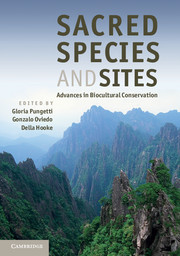Book contents
- Frontmatter
- Contents
- List of Contributors
- Foreword
- Preface
- Acknowledgements
- Introduction
- Part I Concepts and Knowledge
- Part II Sacred Landscapes
- Part III Sacred Sites and People
- Part IV Sacred Species
- Part V Sacred Animals
- Part VI Sacred Groves and Plants
- 21 The sacred tree in the belief and mythology of England
- 22 Sacred groves and biodiversity conservation: a case study from the Western Ghats, India
- 23 Cultural and conservation values of sacred forests in Ghana
- 24 Sacred species of Kenyan sacred sites
- Part VII Implementation and Conclusions
- Index
- Plate Section
- References
23 - Cultural and conservation values of sacred forests in Ghana
from Part VI - Sacred Groves and Plants
Published online by Cambridge University Press: 05 August 2012
- Frontmatter
- Contents
- List of Contributors
- Foreword
- Preface
- Acknowledgements
- Introduction
- Part I Concepts and Knowledge
- Part II Sacred Landscapes
- Part III Sacred Sites and People
- Part IV Sacred Species
- Part V Sacred Animals
- Part VI Sacred Groves and Plants
- 21 The sacred tree in the belief and mythology of England
- 22 Sacred groves and biodiversity conservation: a case study from the Western Ghats, India
- 23 Cultural and conservation values of sacred forests in Ghana
- 24 Sacred species of Kenyan sacred sites
- Part VII Implementation and Conclusions
- Index
- Plate Section
- References
Summary
Introduction
Sacred sites, including sacred forests or sacred groves, are sites that have local cultural or spiritual significance. Sacred forests have been protected around the world for a variety of reasons, including for religious practices or ceremonies, as burial grounds, and for their watershed value (Castro, 1990; Dorm-Adzobu et al., 1991; Lebbie and Freudenberger, 1996; Tiwari et al., 1998; Chouin, 2002; Greene, 2002). There are often myths associated with sacred sites and taboos pertaining to the use of plants and the hunting of animals within the area. The size of groves varies greatly from very small plots (less than 1 ha) to larger tracts of several thousand hectares (Ntiamoa-Baidu, 1995).
Many places in the world have sacred natural sites, but certain countries stand out for the number and age of sites, specifically Ghana and India. Ghana, with over 1900 sacred groves, has a long history of community protection of sacred sites for cultural reasons (Ntiamoa-Baidu, 1995). These sites are commonly referred to as fetish groves and may contain a shrine or serve as burial grounds (Amoako-Atta, 1995). Local residents often believe that these forests are inhabited by ancestor spirits or a god.
Some sacred sites in Ghana, such as Boabeng–Fiema Monkey Sanctuary, are officially protected sites, but the majority of sites are culturally protected lands and vulnerable to the changing values and practices of the people living around them.
- Type
- Chapter
- Information
- Sacred Species and SitesAdvances in Biocultural Conservation, pp. 335 - 350Publisher: Cambridge University PressPrint publication year: 2012
References
- 7
- Cited by

